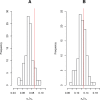Hemizygosity Enhances Purifying Selection: Lack of Fast-Z Evolution in Two Satyrine Butterflies
- PMID: 27590089
- PMCID: PMC5174731
- DOI: 10.1093/gbe/evw214
Hemizygosity Enhances Purifying Selection: Lack of Fast-Z Evolution in Two Satyrine Butterflies
Abstract
The fixation probability of a recessive beneficial mutation is increased on the X or Z chromosome, relative to autosomes, because recessive alleles carried by X or Z are exposed to selection in the heterogametic sex. This leads to an increased dN/dS ratio on sex chromosomes relative to autosomes, a pattern called the "fast-X" or "fast-Z" effect. Besides positive selection, the strength of genetic drift and the efficacy of purifying selection, which affect the rate of molecular evolution, might differ between sex chromosomes and autosomes. Disentangling the complex effects of these distinct forces requires the genome-wide analysis of polymorphism, divergence and gene expression data in a variety of taxa. Here we study the influence of hemizygosity of the Z chromosome in Maniola jurtina and Pyronia tithonus, two species of butterflies (Lepidoptera, Nymphalidae, Satyrinae). Using transcriptome data, we compare the strength of positive and negative selection between Z and autosomes accounting for sex-specific gene expression. We show that M. jurtina and P. tithonus do not experience a faster, but rather a slightly slower evolutionary rate on the Z than on autosomes. Our analysis failed to detect a significant difference in adaptive evolutionary rate between Z and autosomes, but comparison of male-biased, unbiased and female-biased Z-linked genes revealed an increased efficacy of purifying selection against recessive deleterious mutations in female-biased Z-linked genes. This probably contributes to the lack of fast-Z evolution of satyrines. We suggest that the effect of hemizygosity on the fate of recessive deleterious mutations should be taken into account when interpreting patterns of molecular evolution in sex chromosomes vs. autosomes.
Keywords: Lepidoptera; Nymphalidae; fast-Z effect; sex-biased expression; sex-chromosome evolution; transcriptomics.
© The Author 2016. Published by Oxford University Press on behalf of the Society for Molecular Biology and Evolution.
Figures




References
Publication types
MeSH terms
LinkOut - more resources
Full Text Sources
Other Literature Sources

